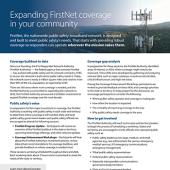This blog is a repost from the Journal of Emergency Medical Services, originally published in October 2023.
The EMS community has much to offer smalltown and rural America where healthcare options are dwindling.
While staffing shortages, travel distances, and budget constraints are closing doors of much-needed rural health services, EMS can help fill those gaps and bring new opportunities to these communities.
The remote region of Jackman, Maine, was experiencing these very constraints in healthcare options, especially on nights and weekends when the local health clinic was closed. Through an innovative telehealth project, the region now has 24/7 urgent care. Paramedics treat patients after hours using technology to consult — in real time — with emergency physicians at a hospital 120 miles away.
The project was not without its challenges. Yet the region was committed to finding a way to provide health care to its residents. The keys to the program’s success include: public safety broadband, widely available technology, and advanced medical training for local paramedics.
Isolated natural beauty, limited healthcare options
The Jackman region — 3 organized towns and 19 unorganized townships — is nestled in the Moose River Valley in the Northwest Mountains of Maine near the Canadian border. The region has been dubbed an “inland island” because of its isolation among the vast woodlands and over 60 lakes, rivers, and ponds. It’s the ideal spot for an outdoor adventurer but can prove difficult if you need to get to a nearby hospital.
The area is served by one healthcare clinic staffed by one doctor. Originally designed in the 1960s as a hospital with a senior care facility, the clinic had to scale back its size and scope over the years due to the high costs of running the facility in a remote region.
Innovative telehealth project relies on EMS
When the clinic looked like it might have to shut down, Penobscot Community Health Care stepped in to take over the clinic and ensure the community continued to receive care, including after-hours urgent and stabilizing emergency care by the clinic staff. However staffing challenges and budget constraints threatened to eliminate the after-hours care, and residents would have faced a one-hour commute to the nearest hospital on nights and weekends.
The town needed another option. “When we started, we walked into a community that knew it was potentially losing access to after-hours urgent care,” said Dr. Jonnathan Busko, Medical Director of Care Delivery Transformation and Associate Medical Director of the Emergency Department at St. Joseph Hospital in the city of Bangor, 120 miles away from Jackman.
Dr. Busko began his medical career as an EMT and later served as a paramedic before becoming an emergency room physician, so he knows the important role EMS officials play in emergency care. He had the idea to bring emergency physicians from St. Joseph’s Hospital to Jackman — without the two-hour drive. Local paramedics would be “physician extenders” in the clinic or in the field.
“It’s pretty important to have that first line of defense here so that we’re not driving 75 miles to the nearest hospital,” said Alan Duplessis, who serves on the town selectboard. “But we are getting the same opinion as if you walked into the emergency room.”
Paramedics and physicians partner through telehealth
Paramedics assess and treat patients after hours at the Jackman clinic by working together with emergency physicians at St. Joseph Hospital. “The key is the paramedics work under a delegated practice of telehealth,” said Rick Petrie, who is chief operating officer of North East Mobile Health Services, the EMS company staffing the clinic.
“Starting at 5:30 at night during the week and on Fridays, Saturdays, Sundays, and holidays, the paramedics establish a telehealth connection with an emergency room physician at St Joe’s,” he continued. “They work collaboratively to care for the patient and get them what they need.” This hybrid telehealth system allows the paramedics to be the eyes, ears, and hands in the room with the patient while the remote emergency physicians provide medical expertise to direct treatment or request transport to a hospital.
To prepare for the role, the paramedics undergo specialized training developed by Dr. Busko and complete clinical rotations at the hospital. In addition to their Maine EMS paramedic scope of practice, these Critical Access Integrated Paramedics (CAIPs) can close wounds; remove embedded foreign bodies like fishhooks and ticks; place fiberglass splints; remove foreign bodies from ears; and perform a number of other urgent care skills.
“We use a protocol-based approach, the way that EMS typically operates,” said Dr. Busko. “And we have specially trained paramedics working under the supervision of a physician to provide advanced care.”
Reliable coverage from public safety broadband
Telemedicine requires a reliable connection, which isn’t always easy to find in remote or rural areas.
“When we first started, even within the clinic, it was hard to get any coverage,” said Dr. Busko. “The cellular coverage up there was pretty thin.”
After careful evaluation, the community decided to build its telehealth program with FirstNet — the nationwide public safety broadband network. They selected FirstNet to ensure paramedics would have a strong, reliable connection — whether treating a patient at the clinic, in the field, or en route to the hospital.
“The paramedics have their phones and tablets that are using FirstNet to be able to communicate, which is important,” said Dr. Patricia Doyle, the Jackman clinic’s sole physician. “Paramedics will always be able to make a connection electronically with the remote provider.”
Technology makes a difference
Another strategic decision for the project in Jackman is its use of widely available technology like laptops, smartphones, and tablets. Specialized telehealth equipment would have been prohibitively expensive for this initiative, which was funded by local taxes and grant money.
“We primarily use iPads for our telehealth connection, and we have the ability to do it with our iPhones as well,” said Rick Petrie.
The paramedics in Jackman also use equipment like illuminators that attach to smartphones to assess the patient and transmit images to doctors in Bangor.
Caleb Frati is a paramedic who staffs the clinic. “We are using technology for diagnostic purposes — wireless otoscopes, stethoscopes, EKG monitors,” he said. “We are able to securely send that information to the physician so they can actually see the assessment portion of what we’re doing here in the field.”
Taking telehealth off-road
The Jackman region’s popularity for outdoor sports means that emergencies often happen away from main roads and easy access points. The region’s first responders are ready to go off-road when needed.
“If we have to go off a paved road for any kind of emergency rescue in a remote location that requires snowmobile, ATV, or by foot, that’s how we go,” said Chief Bill Jarvis of the Jackman-Moose River Fire and Rescue Department that provides basic EMT services for the region.
With telehealth and FirstNet’s broadband connection, an emergency physician can also go on these remote calls. Dr. Busko explained, “We have almost complete coverage for video-level transmission anywhere in our service area.”
The region’s 9-1-1 dispatchers also have the option of sending both an EMT crew and a paramedic to the scene of a medical emergency.
“Now a paramedic can come, assess the patient, give pain medication if need be, review everything with a medical professional through telehealth, and determine if the patient needs to go to the hospital by ambulance,” said Chief Jarvis. “It’s just such a difference for the patient. And it’s reduced the number of ambulance runs and the amount of time the ambulance is gone from the region.”
EMS is the touchstone of healthcare
EMS is playing a critical role in health care in Jackman. “EMS agencies — whether they be a first responder volunteer fire department or full paramedic services — are the touchstones of health care in almost every single community in the United States,” said Dr. Busko. “Particularly in rural areas, you’ll likely find an EMS entity closer to you than any other part of the healthcare system.”
In the Jackman region, the combination of paramedics, telehealth, and a strong broadband connection have provided an innovative solution to the common problem of limited healthcare services in rural areas. When residents have a middle-of-the-night earache or a weekend finger wound, they see a paramedic-physician team at the health clinic, often saving a two-hour roundtrip to the nearest hospital.
“The paramedicine program that we are now operating out of the Jackman Health Center really means everything to us today,” said Alan Duplessis. “It was the best thing — and probably the most modern thing — we could have done for this town and still keep that door open 24 hours a day.”




















